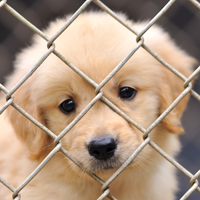It looks like 2014 is poised to be a banner year for animals in the state of Ohio. The Buckeye State is set to ring in the New Year the right way as a milestone piece of animal protection legislation goes into effect January 1, 2014.
Back in late 2012, DogTime.com first told you about Ohio Senate Bill 130, a measure that strongly regulates large-scale breeding operations in Ohio. From instituting annual inspections to overseeing new standards of care, the law aims to put puppy mills out of business and better protect animals at kennels across the state. High-volume breeders must also register with the Ohio Department of Agriculture, the agency who will keep tabs on these commercial breeders.
Gov. John Kasich signed the bill into law on December 11, 2012, to the resounding cheers of animal advocates across the state. And while parts of the law went into effect in March, the full requirements about standards of care and licensing will be enforced beginning New Year’s Day.
As part of the new legislation, dog breeders who produce 9 or more litters, or house 60 or more dogs in one calendar year must purchase a state license for between $150 to $750, depending on the size of the operation and the number of animals.
This means that by the end of December 31, 2013, all large-scale breeding facilities must be registered and licensed or face steep fines.
Dog retailers, the middlemen who purchase pets from these breeders and sell them to pet stores, must also obtain a license for $500. Hopefully this will make it more difficult for unscrupulous puppy mill operators to make quick cash for their mistreated animals.
Because lawmakers also hope to protect pets from misguided or ill-prepared rescuers housing homeless animals in substandard and poorly-run facilities, animal rescue agencies must follow the same licensing and registration protocol, Opposing Views reports.
Some so-called rescues have actually provided big business for puppy mill owners, experts explain. By purchasing dogs from puppy mill auctions and off of Craigslist under the impression that they are rescuing dogs, these misguided do-gooders are just putting money in the pockets of those who exploit pets for a profit. A puppy mill operator who spoke at Senate Bill 130 hearings in 2012 confirmed this, telling the crowd that these “rescues” have helped keep him in business.
To prevent this phenomenon, the new Ohio law prevents a person from purchasing more than 9 dogs each year.
Animal advocates in Ohio say they are already noticing positive changes occurring as a result of the new law.
“Many breeders have closed down,” says Senate Bill 130 supporter Martha Leary. “I can go through all my old puppy mill routes and more than half of the breeders are gone. Cage sizes for dogs have changed drastically [much larger, and they are required to provide] mandatory vet care.”
The law was a long time coming; with stories like this one and of course this one, advocates in Ohio and across the country are applauding the new and much stricter legislation. The Columbus Dispatch reports that lawmakers have tried for more than seven years to pass a law like this one, a law that will crack down on the prevalence of puppy mills in a state where commercial breeding operations have run rampant for years. The American Society for the Prevention of Cruelty to Animals (ASPCA) lists Ohio as one of the states with the highest concentration of puppy mills, alongside Pennsylvania, upstate New York, and Missouri.
Back in 2012, the Marion Star estimated that as many as 8,000 kennels may have been up and running in the state of Ohio, though because of lax regulation there was no telling what the true number could be. Spokesperson for the Ohio Department of Agriculture says that 300 people self-identified as large-scale breeders in a survey conducted earlier this year. As of December 28, 13 breeder licenses have been completed and another 97 are in progress, with more applications coming in every day that the deadline grows closer.
Advocates feel that after the passage of Senate Bill 130, and as long as the law is properly enforced, Ohio could serve as an example for other states hoping to improve their animal protection laws and put puppy mills in their state out of business.
According to the Animal Legal Defense Fund’s (ALDF) 2013 annual Animal Protection Laws Rankings report, Ohio ranks 26 out of 56 U.S. states and recognized territories when it comes to the strength of their animal protection legislation, nestled between Vermont at 25 and Texas at 27. This is a marked improvement over Ohio’s 2012 ranking at 34.
For more information on what you can do to combat puppy mills and save pets in your neck of the woods, or to learn where your state’s animal protection laws rank, check out the ALDF’s website today.
Sources: ALDF.org, Opposing Views, The Columbus Dispatch, ASPCA




